Masters Dissertation: Leadership, Decision-Making, and Sustainability
VerifiedAdded on 2019/09/16
|63
|18495
|380
Thesis and Dissertation
AI Summary
This dissertation investigates the relationship between leadership, decision-making, and organizational sustainability, focusing on a medical device group operating in Israel and internationally. The research examines leadership traits, comparing public and private sector leadership styles, and analyzes their impact on managerial decision-making and organizational sustainability. The study explores various leadership types, including autocratic, democratic, transactional, transformational, laissez-faire, and situational, highlighting their relevance within the organizational context. It delves into the differences in leadership approaches between the public and private sectors, considering factors such as business objectives, stakeholder expectations, and work culture. The research also details the organizational decision-making process, outlining the steps involved in making prudent strategic decisions. Furthermore, it emphasizes the concept of sustainable leadership, focusing on the well-being of stakeholders and the long-term sustainability of the organization within the broader societal context. The study concludes with an analysis of the organization's performance, the impact of leadership changes, and the importance of effective decision-making for achieving organizational goals and sustainability.
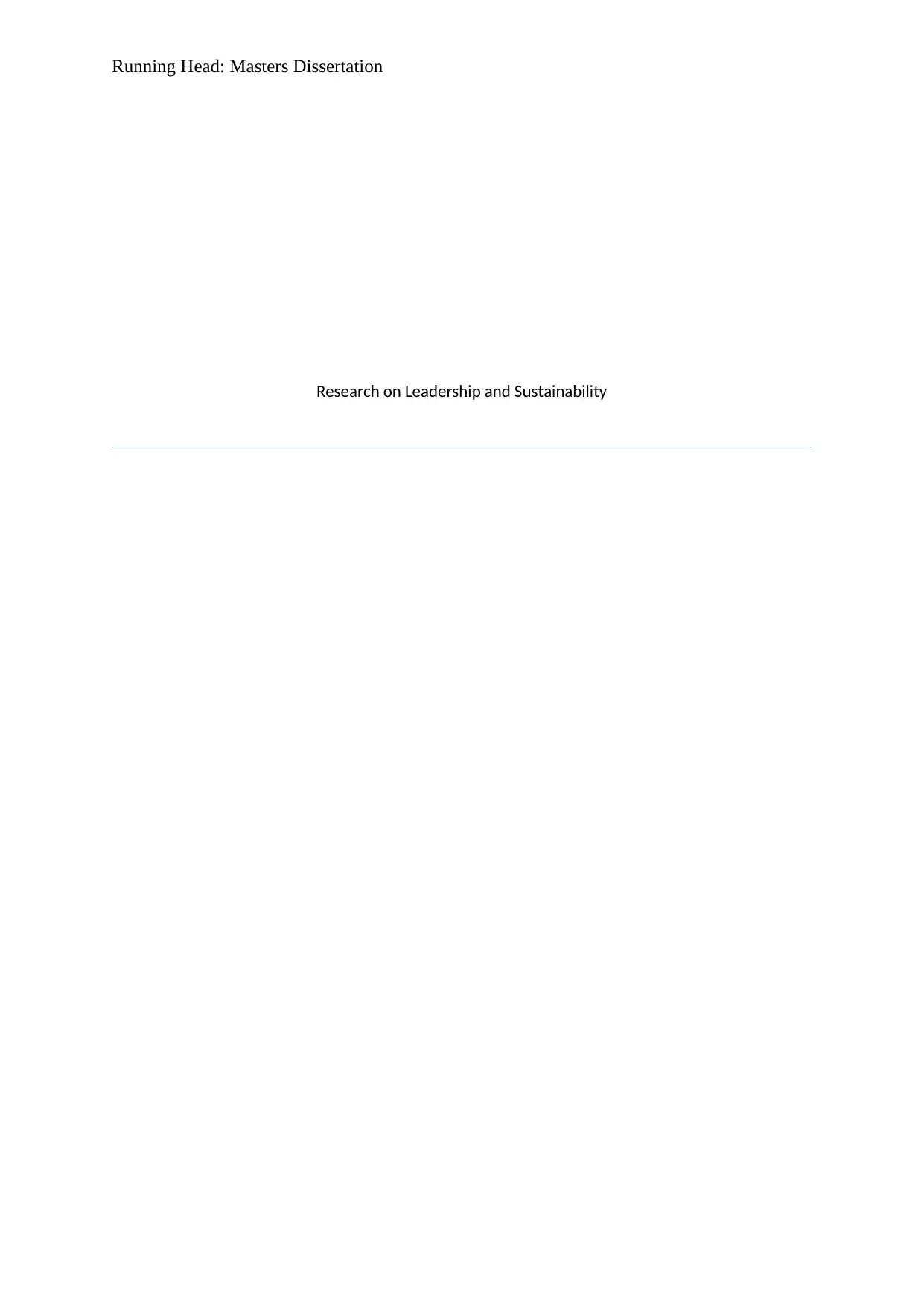
Running Head: Masters Dissertation
Research on Leadership and Sustainability
Research on Leadership and Sustainability
Paraphrase This Document
Need a fresh take? Get an instant paraphrase of this document with our AI Paraphraser
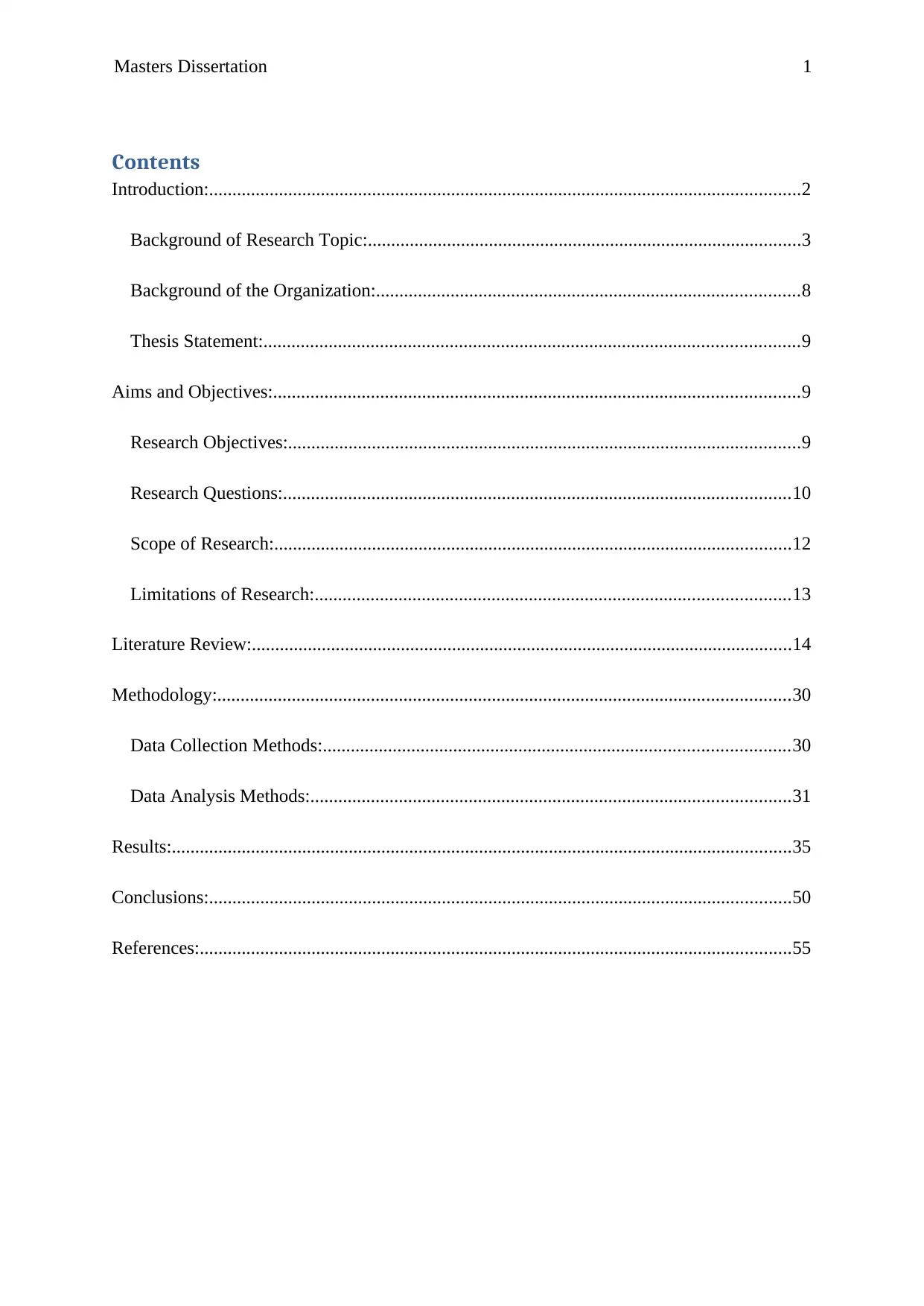
Masters Dissertation 1
Contents
Introduction:...............................................................................................................................2
Background of Research Topic:.............................................................................................3
Background of the Organization:...........................................................................................8
Thesis Statement:...................................................................................................................9
Aims and Objectives:.................................................................................................................9
Research Objectives:..............................................................................................................9
Research Questions:.............................................................................................................10
Scope of Research:...............................................................................................................12
Limitations of Research:......................................................................................................13
Literature Review:....................................................................................................................14
Methodology:...........................................................................................................................30
Data Collection Methods:....................................................................................................30
Data Analysis Methods:.......................................................................................................31
Results:.....................................................................................................................................35
Conclusions:.............................................................................................................................50
References:...............................................................................................................................55
Contents
Introduction:...............................................................................................................................2
Background of Research Topic:.............................................................................................3
Background of the Organization:...........................................................................................8
Thesis Statement:...................................................................................................................9
Aims and Objectives:.................................................................................................................9
Research Objectives:..............................................................................................................9
Research Questions:.............................................................................................................10
Scope of Research:...............................................................................................................12
Limitations of Research:......................................................................................................13
Literature Review:....................................................................................................................14
Methodology:...........................................................................................................................30
Data Collection Methods:....................................................................................................30
Data Analysis Methods:.......................................................................................................31
Results:.....................................................................................................................................35
Conclusions:.............................................................................................................................50
References:...............................................................................................................................55
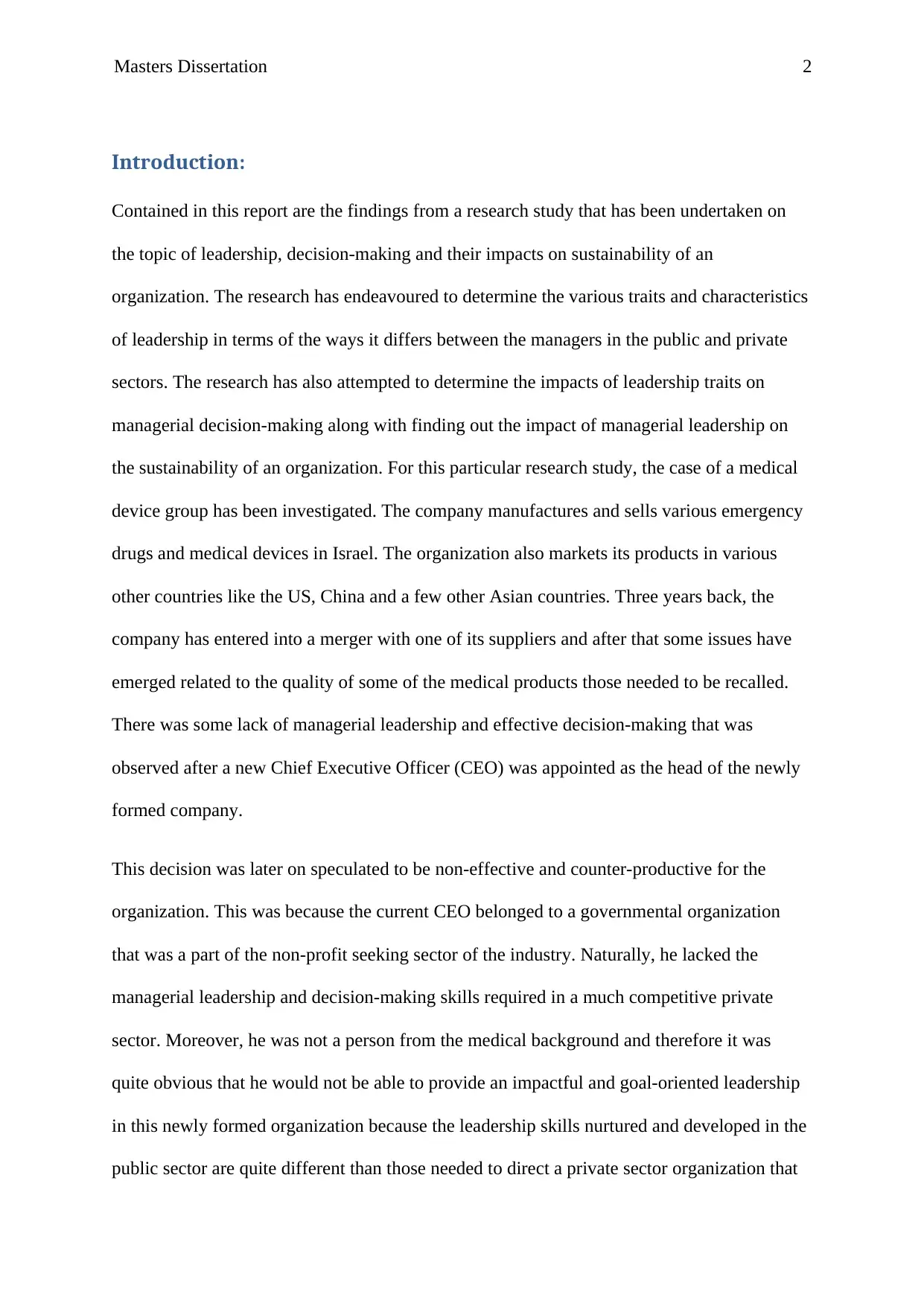
Masters Dissertation 2
Introduction:
Contained in this report are the findings from a research study that has been undertaken on
the topic of leadership, decision-making and their impacts on sustainability of an
organization. The research has endeavoured to determine the various traits and characteristics
of leadership in terms of the ways it differs between the managers in the public and private
sectors. The research has also attempted to determine the impacts of leadership traits on
managerial decision-making along with finding out the impact of managerial leadership on
the sustainability of an organization. For this particular research study, the case of a medical
device group has been investigated. The company manufactures and sells various emergency
drugs and medical devices in Israel. The organization also markets its products in various
other countries like the US, China and a few other Asian countries. Three years back, the
company has entered into a merger with one of its suppliers and after that some issues have
emerged related to the quality of some of the medical products those needed to be recalled.
There was some lack of managerial leadership and effective decision-making that was
observed after a new Chief Executive Officer (CEO) was appointed as the head of the newly
formed company.
This decision was later on speculated to be non-effective and counter-productive for the
organization. This was because the current CEO belonged to a governmental organization
that was a part of the non-profit seeking sector of the industry. Naturally, he lacked the
managerial leadership and decision-making skills required in a much competitive private
sector. Moreover, he was not a person from the medical background and therefore it was
quite obvious that he would not be able to provide an impactful and goal-oriented leadership
in this newly formed organization because the leadership skills nurtured and developed in the
public sector are quite different than those needed to direct a private sector organization that
Introduction:
Contained in this report are the findings from a research study that has been undertaken on
the topic of leadership, decision-making and their impacts on sustainability of an
organization. The research has endeavoured to determine the various traits and characteristics
of leadership in terms of the ways it differs between the managers in the public and private
sectors. The research has also attempted to determine the impacts of leadership traits on
managerial decision-making along with finding out the impact of managerial leadership on
the sustainability of an organization. For this particular research study, the case of a medical
device group has been investigated. The company manufactures and sells various emergency
drugs and medical devices in Israel. The organization also markets its products in various
other countries like the US, China and a few other Asian countries. Three years back, the
company has entered into a merger with one of its suppliers and after that some issues have
emerged related to the quality of some of the medical products those needed to be recalled.
There was some lack of managerial leadership and effective decision-making that was
observed after a new Chief Executive Officer (CEO) was appointed as the head of the newly
formed company.
This decision was later on speculated to be non-effective and counter-productive for the
organization. This was because the current CEO belonged to a governmental organization
that was a part of the non-profit seeking sector of the industry. Naturally, he lacked the
managerial leadership and decision-making skills required in a much competitive private
sector. Moreover, he was not a person from the medical background and therefore it was
quite obvious that he would not be able to provide an impactful and goal-oriented leadership
in this newly formed organization because the leadership skills nurtured and developed in the
public sector are quite different than those needed to direct a private sector organization that
⊘ This is a preview!⊘
Do you want full access?
Subscribe today to unlock all pages.

Trusted by 1+ million students worldwide
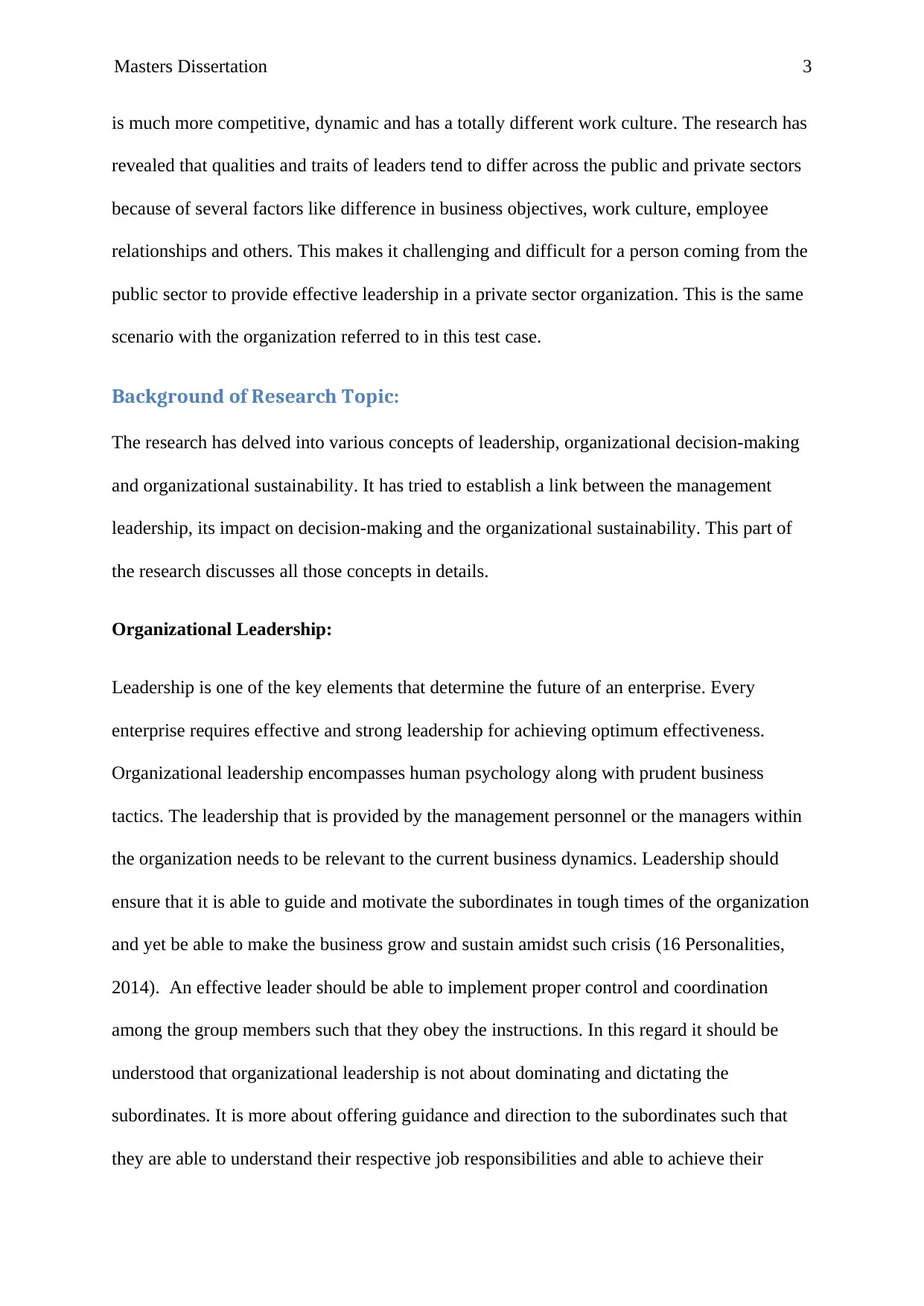
Masters Dissertation 3
is much more competitive, dynamic and has a totally different work culture. The research has
revealed that qualities and traits of leaders tend to differ across the public and private sectors
because of several factors like difference in business objectives, work culture, employee
relationships and others. This makes it challenging and difficult for a person coming from the
public sector to provide effective leadership in a private sector organization. This is the same
scenario with the organization referred to in this test case.
Background of Research Topic:
The research has delved into various concepts of leadership, organizational decision-making
and organizational sustainability. It has tried to establish a link between the management
leadership, its impact on decision-making and the organizational sustainability. This part of
the research discusses all those concepts in details.
Organizational Leadership:
Leadership is one of the key elements that determine the future of an enterprise. Every
enterprise requires effective and strong leadership for achieving optimum effectiveness.
Organizational leadership encompasses human psychology along with prudent business
tactics. The leadership that is provided by the management personnel or the managers within
the organization needs to be relevant to the current business dynamics. Leadership should
ensure that it is able to guide and motivate the subordinates in tough times of the organization
and yet be able to make the business grow and sustain amidst such crisis (16 Personalities,
2014). An effective leader should be able to implement proper control and coordination
among the group members such that they obey the instructions. In this regard it should be
understood that organizational leadership is not about dominating and dictating the
subordinates. It is more about offering guidance and direction to the subordinates such that
they are able to understand their respective job responsibilities and able to achieve their
is much more competitive, dynamic and has a totally different work culture. The research has
revealed that qualities and traits of leaders tend to differ across the public and private sectors
because of several factors like difference in business objectives, work culture, employee
relationships and others. This makes it challenging and difficult for a person coming from the
public sector to provide effective leadership in a private sector organization. This is the same
scenario with the organization referred to in this test case.
Background of Research Topic:
The research has delved into various concepts of leadership, organizational decision-making
and organizational sustainability. It has tried to establish a link between the management
leadership, its impact on decision-making and the organizational sustainability. This part of
the research discusses all those concepts in details.
Organizational Leadership:
Leadership is one of the key elements that determine the future of an enterprise. Every
enterprise requires effective and strong leadership for achieving optimum effectiveness.
Organizational leadership encompasses human psychology along with prudent business
tactics. The leadership that is provided by the management personnel or the managers within
the organization needs to be relevant to the current business dynamics. Leadership should
ensure that it is able to guide and motivate the subordinates in tough times of the organization
and yet be able to make the business grow and sustain amidst such crisis (16 Personalities,
2014). An effective leader should be able to implement proper control and coordination
among the group members such that they obey the instructions. In this regard it should be
understood that organizational leadership is not about dominating and dictating the
subordinates. It is more about offering guidance and direction to the subordinates such that
they are able to understand their respective job responsibilities and able to achieve their
Paraphrase This Document
Need a fresh take? Get an instant paraphrase of this document with our AI Paraphraser
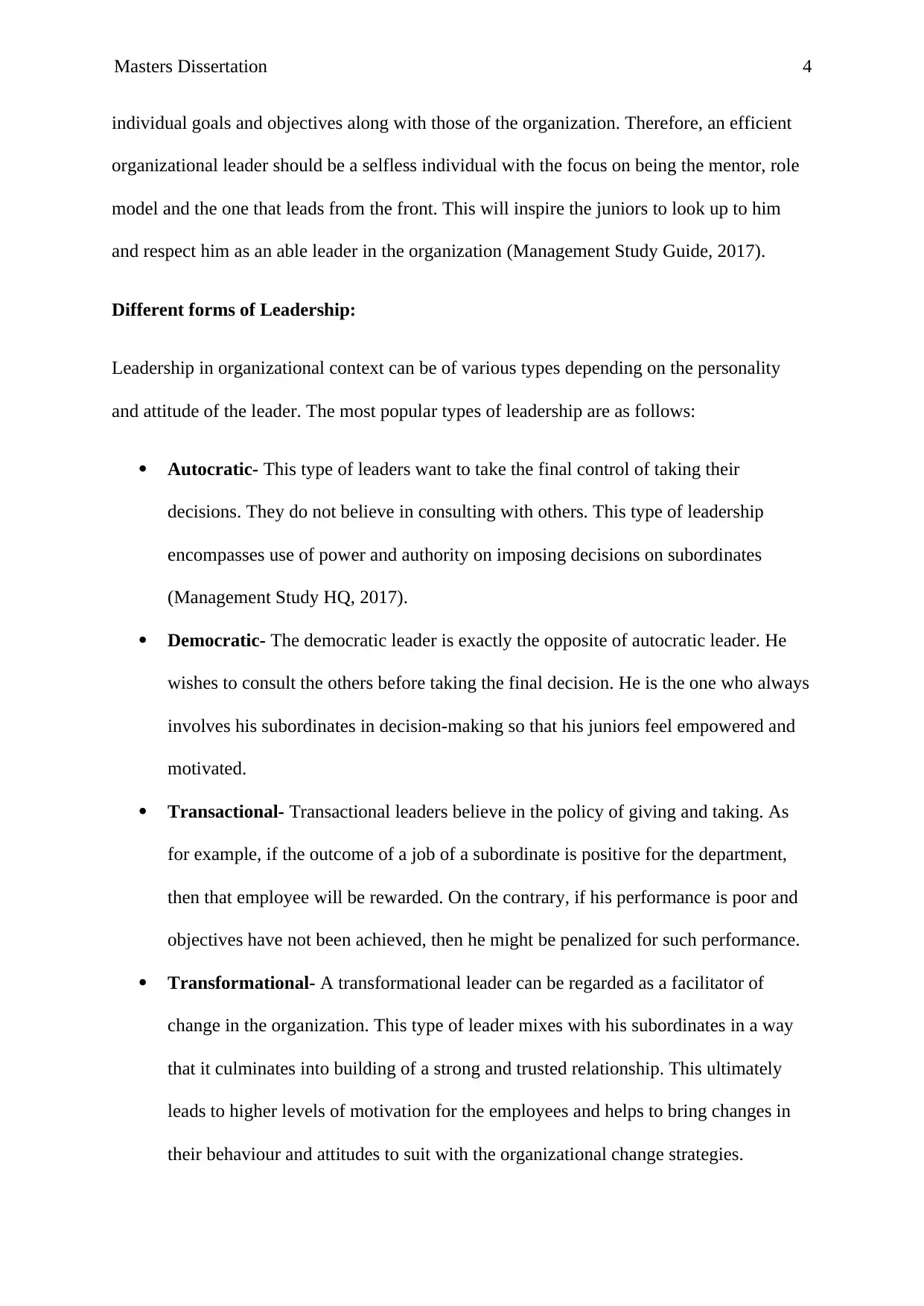
Masters Dissertation 4
individual goals and objectives along with those of the organization. Therefore, an efficient
organizational leader should be a selfless individual with the focus on being the mentor, role
model and the one that leads from the front. This will inspire the juniors to look up to him
and respect him as an able leader in the organization (Management Study Guide, 2017).
Different forms of Leadership:
Leadership in organizational context can be of various types depending on the personality
and attitude of the leader. The most popular types of leadership are as follows:
Autocratic- This type of leaders want to take the final control of taking their
decisions. They do not believe in consulting with others. This type of leadership
encompasses use of power and authority on imposing decisions on subordinates
(Management Study HQ, 2017).
Democratic- The democratic leader is exactly the opposite of autocratic leader. He
wishes to consult the others before taking the final decision. He is the one who always
involves his subordinates in decision-making so that his juniors feel empowered and
motivated.
Transactional- Transactional leaders believe in the policy of giving and taking. As
for example, if the outcome of a job of a subordinate is positive for the department,
then that employee will be rewarded. On the contrary, if his performance is poor and
objectives have not been achieved, then he might be penalized for such performance.
Transformational- A transformational leader can be regarded as a facilitator of
change in the organization. This type of leader mixes with his subordinates in a way
that it culminates into building of a strong and trusted relationship. This ultimately
leads to higher levels of motivation for the employees and helps to bring changes in
their behaviour and attitudes to suit with the organizational change strategies.
individual goals and objectives along with those of the organization. Therefore, an efficient
organizational leader should be a selfless individual with the focus on being the mentor, role
model and the one that leads from the front. This will inspire the juniors to look up to him
and respect him as an able leader in the organization (Management Study Guide, 2017).
Different forms of Leadership:
Leadership in organizational context can be of various types depending on the personality
and attitude of the leader. The most popular types of leadership are as follows:
Autocratic- This type of leaders want to take the final control of taking their
decisions. They do not believe in consulting with others. This type of leadership
encompasses use of power and authority on imposing decisions on subordinates
(Management Study HQ, 2017).
Democratic- The democratic leader is exactly the opposite of autocratic leader. He
wishes to consult the others before taking the final decision. He is the one who always
involves his subordinates in decision-making so that his juniors feel empowered and
motivated.
Transactional- Transactional leaders believe in the policy of giving and taking. As
for example, if the outcome of a job of a subordinate is positive for the department,
then that employee will be rewarded. On the contrary, if his performance is poor and
objectives have not been achieved, then he might be penalized for such performance.
Transformational- A transformational leader can be regarded as a facilitator of
change in the organization. This type of leader mixes with his subordinates in a way
that it culminates into building of a strong and trusted relationship. This ultimately
leads to higher levels of motivation for the employees and helps to bring changes in
their behaviour and attitudes to suit with the organizational change strategies.
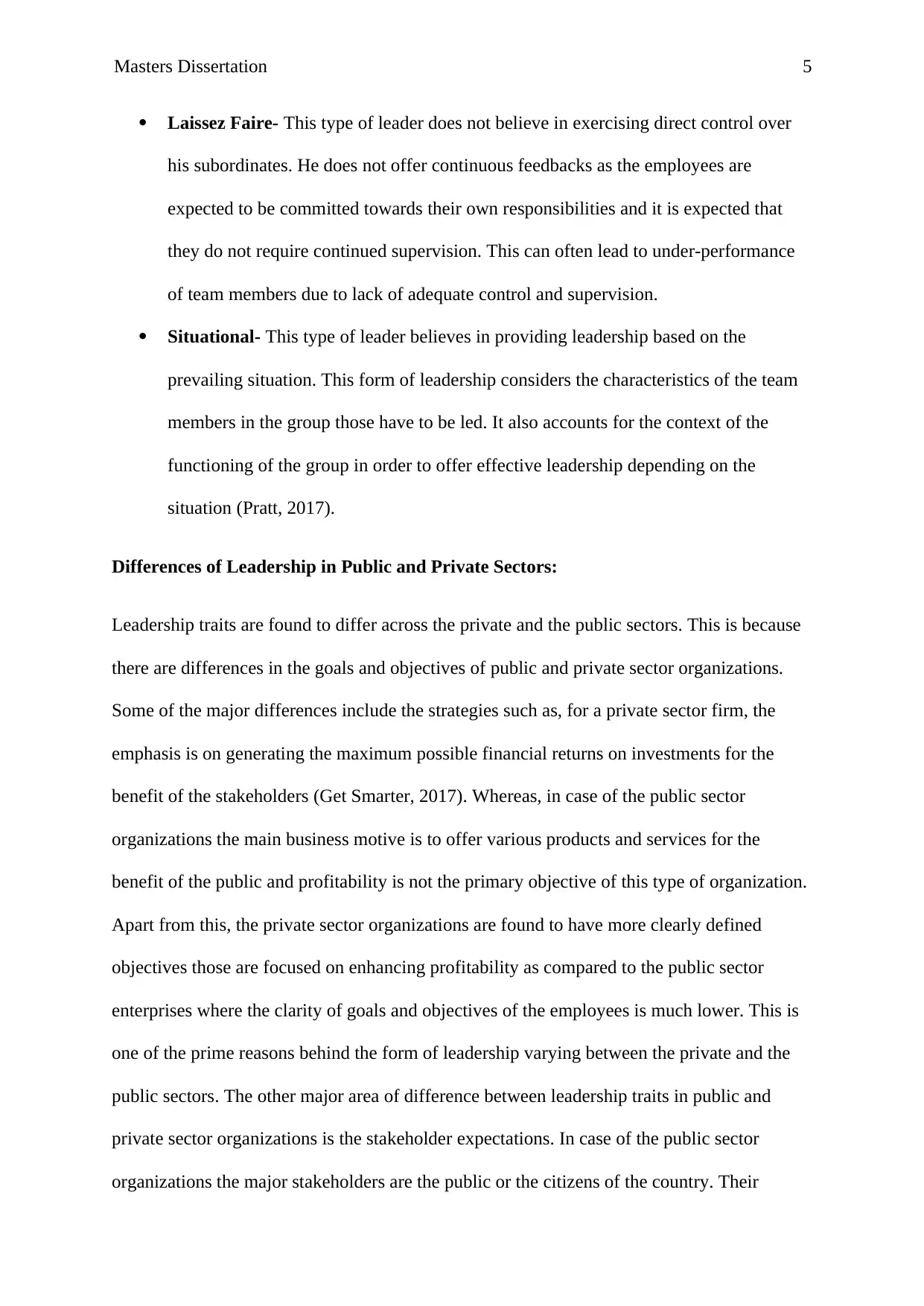
Masters Dissertation 5
Laissez Faire- This type of leader does not believe in exercising direct control over
his subordinates. He does not offer continuous feedbacks as the employees are
expected to be committed towards their own responsibilities and it is expected that
they do not require continued supervision. This can often lead to under-performance
of team members due to lack of adequate control and supervision.
Situational- This type of leader believes in providing leadership based on the
prevailing situation. This form of leadership considers the characteristics of the team
members in the group those have to be led. It also accounts for the context of the
functioning of the group in order to offer effective leadership depending on the
situation (Pratt, 2017).
Differences of Leadership in Public and Private Sectors:
Leadership traits are found to differ across the private and the public sectors. This is because
there are differences in the goals and objectives of public and private sector organizations.
Some of the major differences include the strategies such as, for a private sector firm, the
emphasis is on generating the maximum possible financial returns on investments for the
benefit of the stakeholders (Get Smarter, 2017). Whereas, in case of the public sector
organizations the main business motive is to offer various products and services for the
benefit of the public and profitability is not the primary objective of this type of organization.
Apart from this, the private sector organizations are found to have more clearly defined
objectives those are focused on enhancing profitability as compared to the public sector
enterprises where the clarity of goals and objectives of the employees is much lower. This is
one of the prime reasons behind the form of leadership varying between the private and the
public sectors. The other major area of difference between leadership traits in public and
private sector organizations is the stakeholder expectations. In case of the public sector
organizations the major stakeholders are the public or the citizens of the country. Their
Laissez Faire- This type of leader does not believe in exercising direct control over
his subordinates. He does not offer continuous feedbacks as the employees are
expected to be committed towards their own responsibilities and it is expected that
they do not require continued supervision. This can often lead to under-performance
of team members due to lack of adequate control and supervision.
Situational- This type of leader believes in providing leadership based on the
prevailing situation. This form of leadership considers the characteristics of the team
members in the group those have to be led. It also accounts for the context of the
functioning of the group in order to offer effective leadership depending on the
situation (Pratt, 2017).
Differences of Leadership in Public and Private Sectors:
Leadership traits are found to differ across the private and the public sectors. This is because
there are differences in the goals and objectives of public and private sector organizations.
Some of the major differences include the strategies such as, for a private sector firm, the
emphasis is on generating the maximum possible financial returns on investments for the
benefit of the stakeholders (Get Smarter, 2017). Whereas, in case of the public sector
organizations the main business motive is to offer various products and services for the
benefit of the public and profitability is not the primary objective of this type of organization.
Apart from this, the private sector organizations are found to have more clearly defined
objectives those are focused on enhancing profitability as compared to the public sector
enterprises where the clarity of goals and objectives of the employees is much lower. This is
one of the prime reasons behind the form of leadership varying between the private and the
public sectors. The other major area of difference between leadership traits in public and
private sector organizations is the stakeholder expectations. In case of the public sector
organizations the major stakeholders are the public or the citizens of the country. Their
⊘ This is a preview!⊘
Do you want full access?
Subscribe today to unlock all pages.

Trusted by 1+ million students worldwide
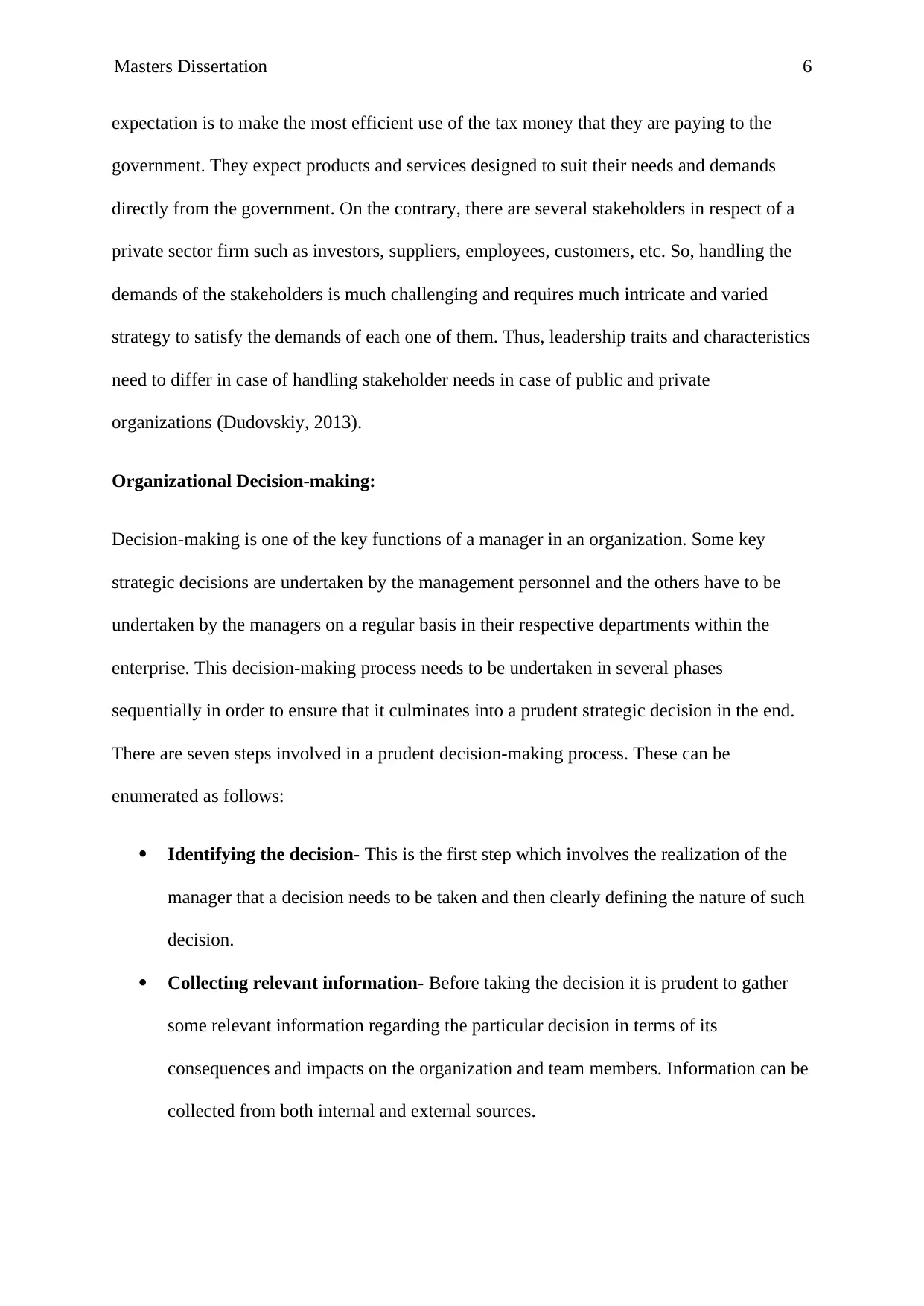
Masters Dissertation 6
expectation is to make the most efficient use of the tax money that they are paying to the
government. They expect products and services designed to suit their needs and demands
directly from the government. On the contrary, there are several stakeholders in respect of a
private sector firm such as investors, suppliers, employees, customers, etc. So, handling the
demands of the stakeholders is much challenging and requires much intricate and varied
strategy to satisfy the demands of each one of them. Thus, leadership traits and characteristics
need to differ in case of handling stakeholder needs in case of public and private
organizations (Dudovskiy, 2013).
Organizational Decision-making:
Decision-making is one of the key functions of a manager in an organization. Some key
strategic decisions are undertaken by the management personnel and the others have to be
undertaken by the managers on a regular basis in their respective departments within the
enterprise. This decision-making process needs to be undertaken in several phases
sequentially in order to ensure that it culminates into a prudent strategic decision in the end.
There are seven steps involved in a prudent decision-making process. These can be
enumerated as follows:
Identifying the decision- This is the first step which involves the realization of the
manager that a decision needs to be taken and then clearly defining the nature of such
decision.
Collecting relevant information- Before taking the decision it is prudent to gather
some relevant information regarding the particular decision in terms of its
consequences and impacts on the organization and team members. Information can be
collected from both internal and external sources.
expectation is to make the most efficient use of the tax money that they are paying to the
government. They expect products and services designed to suit their needs and demands
directly from the government. On the contrary, there are several stakeholders in respect of a
private sector firm such as investors, suppliers, employees, customers, etc. So, handling the
demands of the stakeholders is much challenging and requires much intricate and varied
strategy to satisfy the demands of each one of them. Thus, leadership traits and characteristics
need to differ in case of handling stakeholder needs in case of public and private
organizations (Dudovskiy, 2013).
Organizational Decision-making:
Decision-making is one of the key functions of a manager in an organization. Some key
strategic decisions are undertaken by the management personnel and the others have to be
undertaken by the managers on a regular basis in their respective departments within the
enterprise. This decision-making process needs to be undertaken in several phases
sequentially in order to ensure that it culminates into a prudent strategic decision in the end.
There are seven steps involved in a prudent decision-making process. These can be
enumerated as follows:
Identifying the decision- This is the first step which involves the realization of the
manager that a decision needs to be taken and then clearly defining the nature of such
decision.
Collecting relevant information- Before taking the decision it is prudent to gather
some relevant information regarding the particular decision in terms of its
consequences and impacts on the organization and team members. Information can be
collected from both internal and external sources.
Paraphrase This Document
Need a fresh take? Get an instant paraphrase of this document with our AI Paraphraser
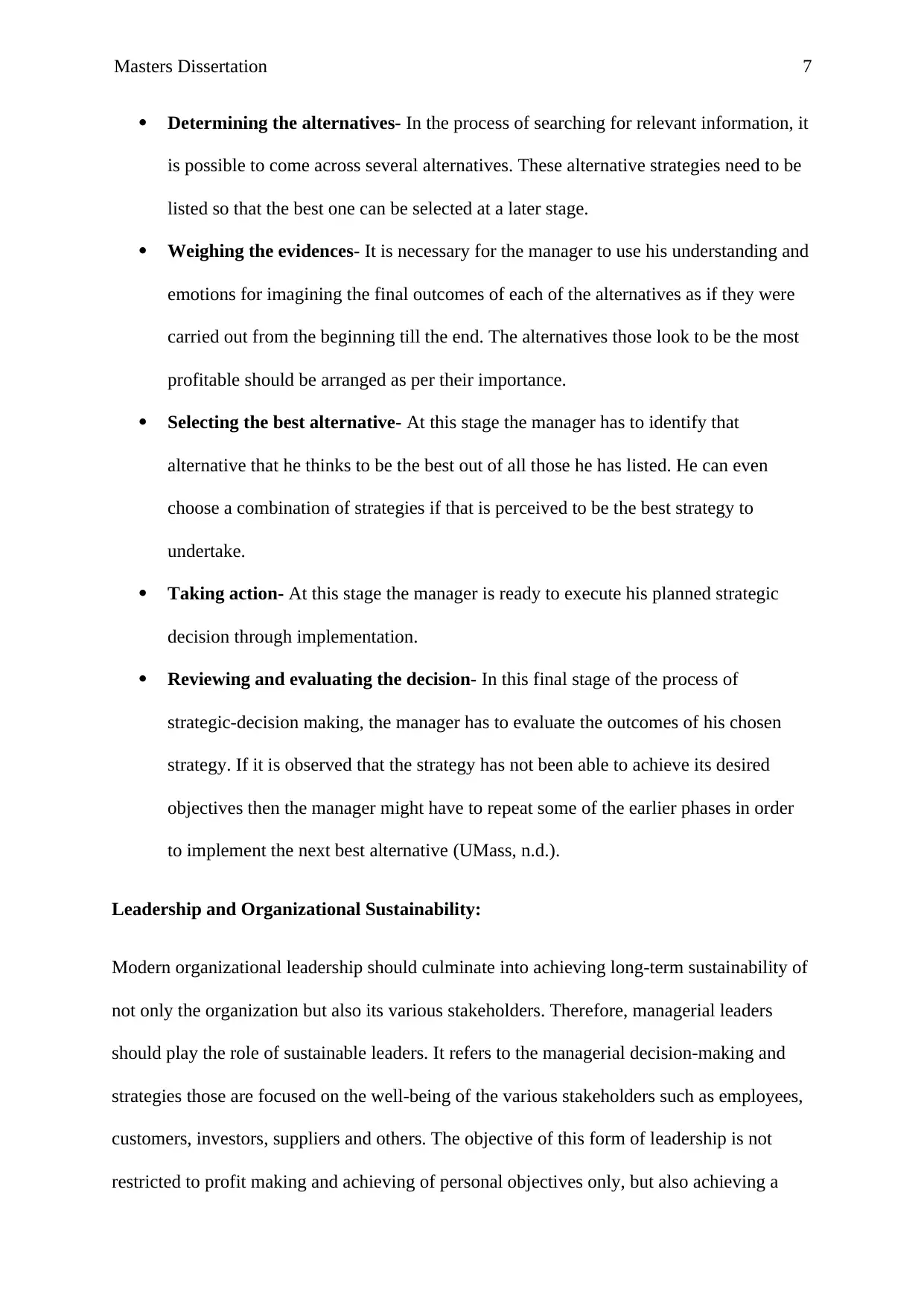
Masters Dissertation 7
Determining the alternatives- In the process of searching for relevant information, it
is possible to come across several alternatives. These alternative strategies need to be
listed so that the best one can be selected at a later stage.
Weighing the evidences- It is necessary for the manager to use his understanding and
emotions for imagining the final outcomes of each of the alternatives as if they were
carried out from the beginning till the end. The alternatives those look to be the most
profitable should be arranged as per their importance.
Selecting the best alternative- At this stage the manager has to identify that
alternative that he thinks to be the best out of all those he has listed. He can even
choose a combination of strategies if that is perceived to be the best strategy to
undertake.
Taking action- At this stage the manager is ready to execute his planned strategic
decision through implementation.
Reviewing and evaluating the decision- In this final stage of the process of
strategic-decision making, the manager has to evaluate the outcomes of his chosen
strategy. If it is observed that the strategy has not been able to achieve its desired
objectives then the manager might have to repeat some of the earlier phases in order
to implement the next best alternative (UMass, n.d.).
Leadership and Organizational Sustainability:
Modern organizational leadership should culminate into achieving long-term sustainability of
not only the organization but also its various stakeholders. Therefore, managerial leaders
should play the role of sustainable leaders. It refers to the managerial decision-making and
strategies those are focused on the well-being of the various stakeholders such as employees,
customers, investors, suppliers and others. The objective of this form of leadership is not
restricted to profit making and achieving of personal objectives only, but also achieving a
Determining the alternatives- In the process of searching for relevant information, it
is possible to come across several alternatives. These alternative strategies need to be
listed so that the best one can be selected at a later stage.
Weighing the evidences- It is necessary for the manager to use his understanding and
emotions for imagining the final outcomes of each of the alternatives as if they were
carried out from the beginning till the end. The alternatives those look to be the most
profitable should be arranged as per their importance.
Selecting the best alternative- At this stage the manager has to identify that
alternative that he thinks to be the best out of all those he has listed. He can even
choose a combination of strategies if that is perceived to be the best strategy to
undertake.
Taking action- At this stage the manager is ready to execute his planned strategic
decision through implementation.
Reviewing and evaluating the decision- In this final stage of the process of
strategic-decision making, the manager has to evaluate the outcomes of his chosen
strategy. If it is observed that the strategy has not been able to achieve its desired
objectives then the manager might have to repeat some of the earlier phases in order
to implement the next best alternative (UMass, n.d.).
Leadership and Organizational Sustainability:
Modern organizational leadership should culminate into achieving long-term sustainability of
not only the organization but also its various stakeholders. Therefore, managerial leaders
should play the role of sustainable leaders. It refers to the managerial decision-making and
strategies those are focused on the well-being of the various stakeholders such as employees,
customers, investors, suppliers and others. The objective of this form of leadership is not
restricted to profit making and achieving of personal objectives only, but also achieving a
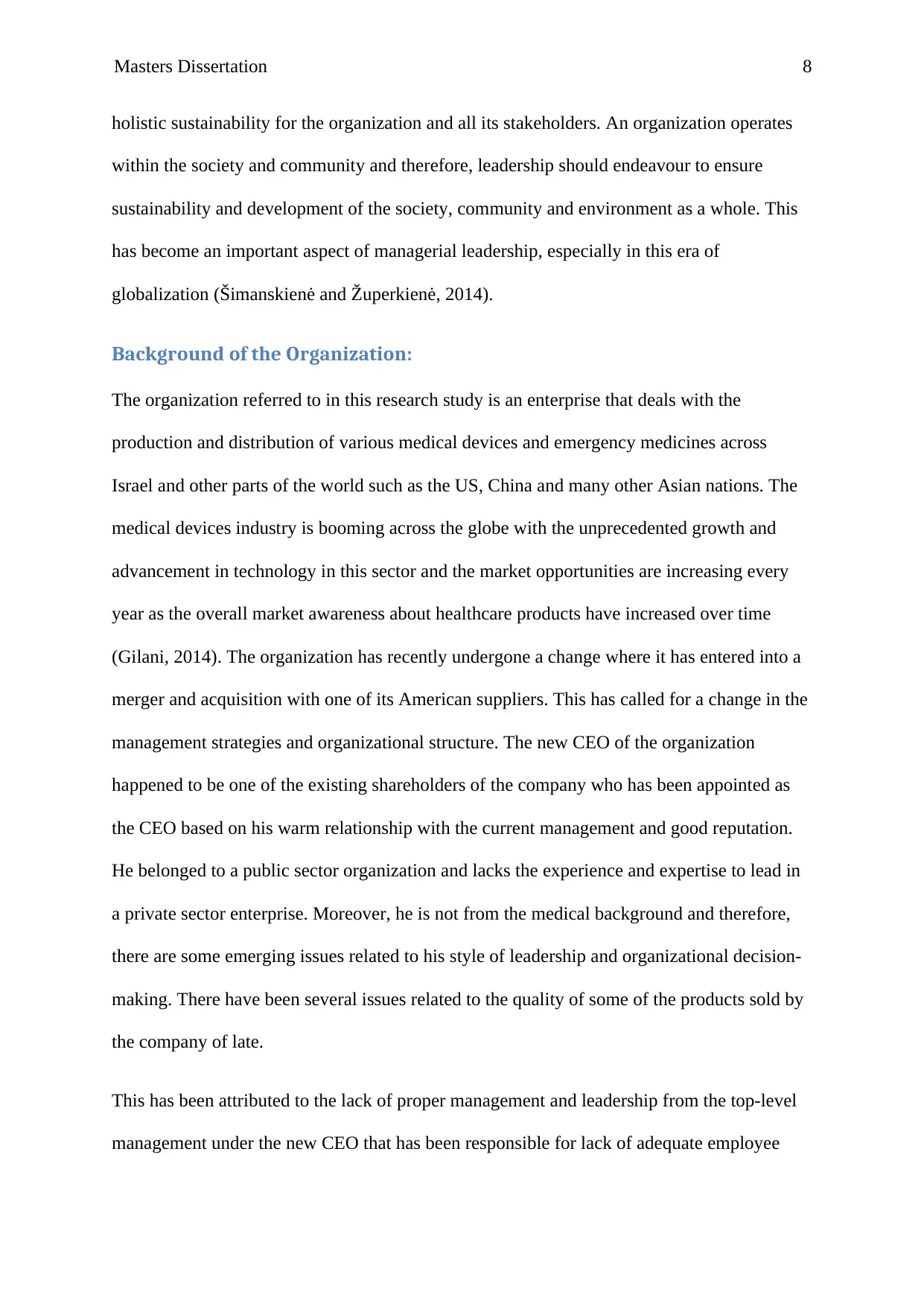
Masters Dissertation 8
holistic sustainability for the organization and all its stakeholders. An organization operates
within the society and community and therefore, leadership should endeavour to ensure
sustainability and development of the society, community and environment as a whole. This
has become an important aspect of managerial leadership, especially in this era of
globalization (Šimanskienė and Župerkienė, 2014).
Background of the Organization:
The organization referred to in this research study is an enterprise that deals with the
production and distribution of various medical devices and emergency medicines across
Israel and other parts of the world such as the US, China and many other Asian nations. The
medical devices industry is booming across the globe with the unprecedented growth and
advancement in technology in this sector and the market opportunities are increasing every
year as the overall market awareness about healthcare products have increased over time
(Gilani, 2014). The organization has recently undergone a change where it has entered into a
merger and acquisition with one of its American suppliers. This has called for a change in the
management strategies and organizational structure. The new CEO of the organization
happened to be one of the existing shareholders of the company who has been appointed as
the CEO based on his warm relationship with the current management and good reputation.
He belonged to a public sector organization and lacks the experience and expertise to lead in
a private sector enterprise. Moreover, he is not from the medical background and therefore,
there are some emerging issues related to his style of leadership and organizational decision-
making. There have been several issues related to the quality of some of the products sold by
the company of late.
This has been attributed to the lack of proper management and leadership from the top-level
management under the new CEO that has been responsible for lack of adequate employee
holistic sustainability for the organization and all its stakeholders. An organization operates
within the society and community and therefore, leadership should endeavour to ensure
sustainability and development of the society, community and environment as a whole. This
has become an important aspect of managerial leadership, especially in this era of
globalization (Šimanskienė and Župerkienė, 2014).
Background of the Organization:
The organization referred to in this research study is an enterprise that deals with the
production and distribution of various medical devices and emergency medicines across
Israel and other parts of the world such as the US, China and many other Asian nations. The
medical devices industry is booming across the globe with the unprecedented growth and
advancement in technology in this sector and the market opportunities are increasing every
year as the overall market awareness about healthcare products have increased over time
(Gilani, 2014). The organization has recently undergone a change where it has entered into a
merger and acquisition with one of its American suppliers. This has called for a change in the
management strategies and organizational structure. The new CEO of the organization
happened to be one of the existing shareholders of the company who has been appointed as
the CEO based on his warm relationship with the current management and good reputation.
He belonged to a public sector organization and lacks the experience and expertise to lead in
a private sector enterprise. Moreover, he is not from the medical background and therefore,
there are some emerging issues related to his style of leadership and organizational decision-
making. There have been several issues related to the quality of some of the products sold by
the company of late.
This has been attributed to the lack of proper management and leadership from the top-level
management under the new CEO that has been responsible for lack of adequate employee
⊘ This is a preview!⊘
Do you want full access?
Subscribe today to unlock all pages.

Trusted by 1+ million students worldwide
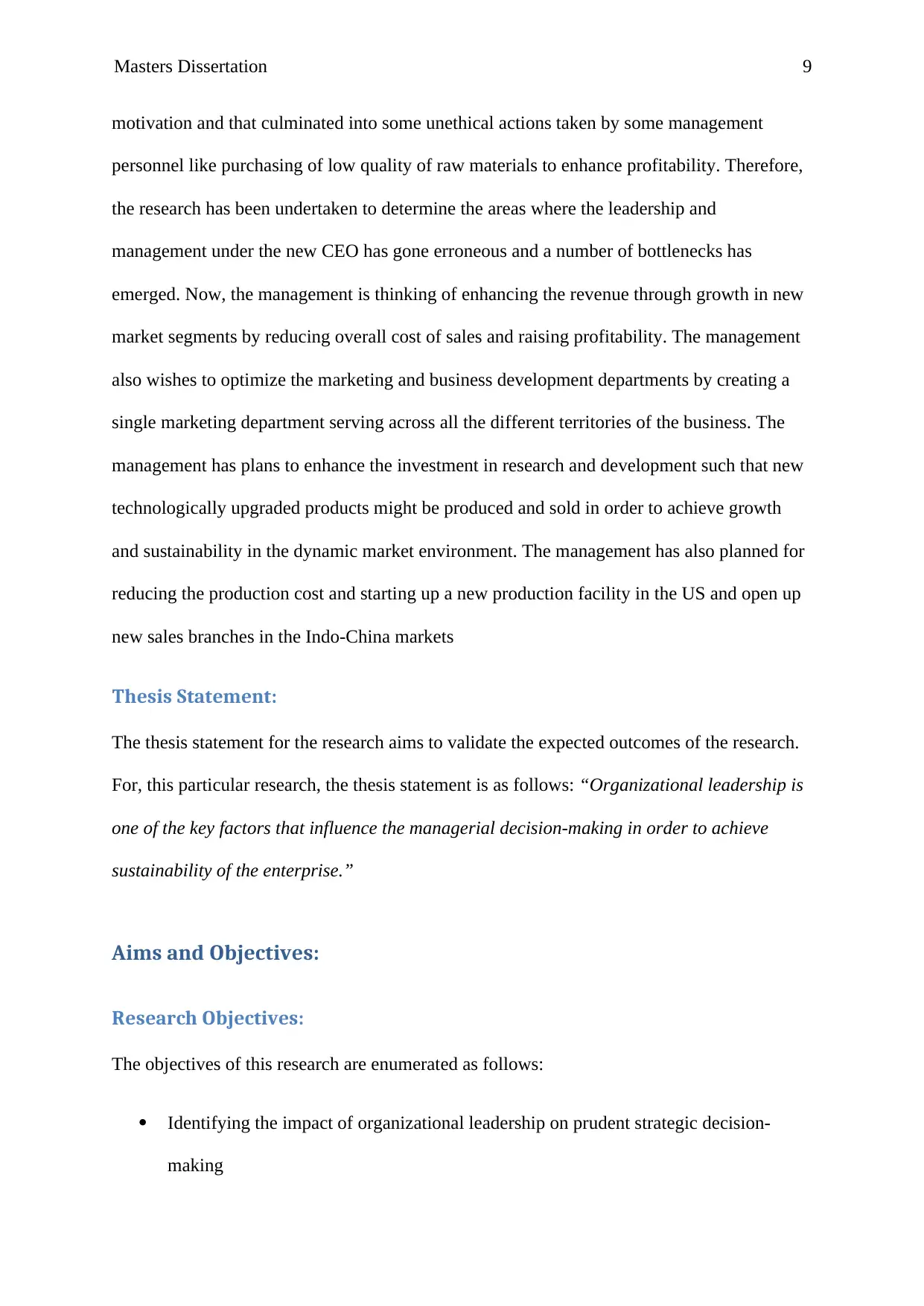
Masters Dissertation 9
motivation and that culminated into some unethical actions taken by some management
personnel like purchasing of low quality of raw materials to enhance profitability. Therefore,
the research has been undertaken to determine the areas where the leadership and
management under the new CEO has gone erroneous and a number of bottlenecks has
emerged. Now, the management is thinking of enhancing the revenue through growth in new
market segments by reducing overall cost of sales and raising profitability. The management
also wishes to optimize the marketing and business development departments by creating a
single marketing department serving across all the different territories of the business. The
management has plans to enhance the investment in research and development such that new
technologically upgraded products might be produced and sold in order to achieve growth
and sustainability in the dynamic market environment. The management has also planned for
reducing the production cost and starting up a new production facility in the US and open up
new sales branches in the Indo-China markets
Thesis Statement:
The thesis statement for the research aims to validate the expected outcomes of the research.
For, this particular research, the thesis statement is as follows: “Organizational leadership is
one of the key factors that influence the managerial decision-making in order to achieve
sustainability of the enterprise.”
Aims and Objectives:
Research Objectives:
The objectives of this research are enumerated as follows:
Identifying the impact of organizational leadership on prudent strategic decision-
making
motivation and that culminated into some unethical actions taken by some management
personnel like purchasing of low quality of raw materials to enhance profitability. Therefore,
the research has been undertaken to determine the areas where the leadership and
management under the new CEO has gone erroneous and a number of bottlenecks has
emerged. Now, the management is thinking of enhancing the revenue through growth in new
market segments by reducing overall cost of sales and raising profitability. The management
also wishes to optimize the marketing and business development departments by creating a
single marketing department serving across all the different territories of the business. The
management has plans to enhance the investment in research and development such that new
technologically upgraded products might be produced and sold in order to achieve growth
and sustainability in the dynamic market environment. The management has also planned for
reducing the production cost and starting up a new production facility in the US and open up
new sales branches in the Indo-China markets
Thesis Statement:
The thesis statement for the research aims to validate the expected outcomes of the research.
For, this particular research, the thesis statement is as follows: “Organizational leadership is
one of the key factors that influence the managerial decision-making in order to achieve
sustainability of the enterprise.”
Aims and Objectives:
Research Objectives:
The objectives of this research are enumerated as follows:
Identifying the impact of organizational leadership on prudent strategic decision-
making
Paraphrase This Document
Need a fresh take? Get an instant paraphrase of this document with our AI Paraphraser
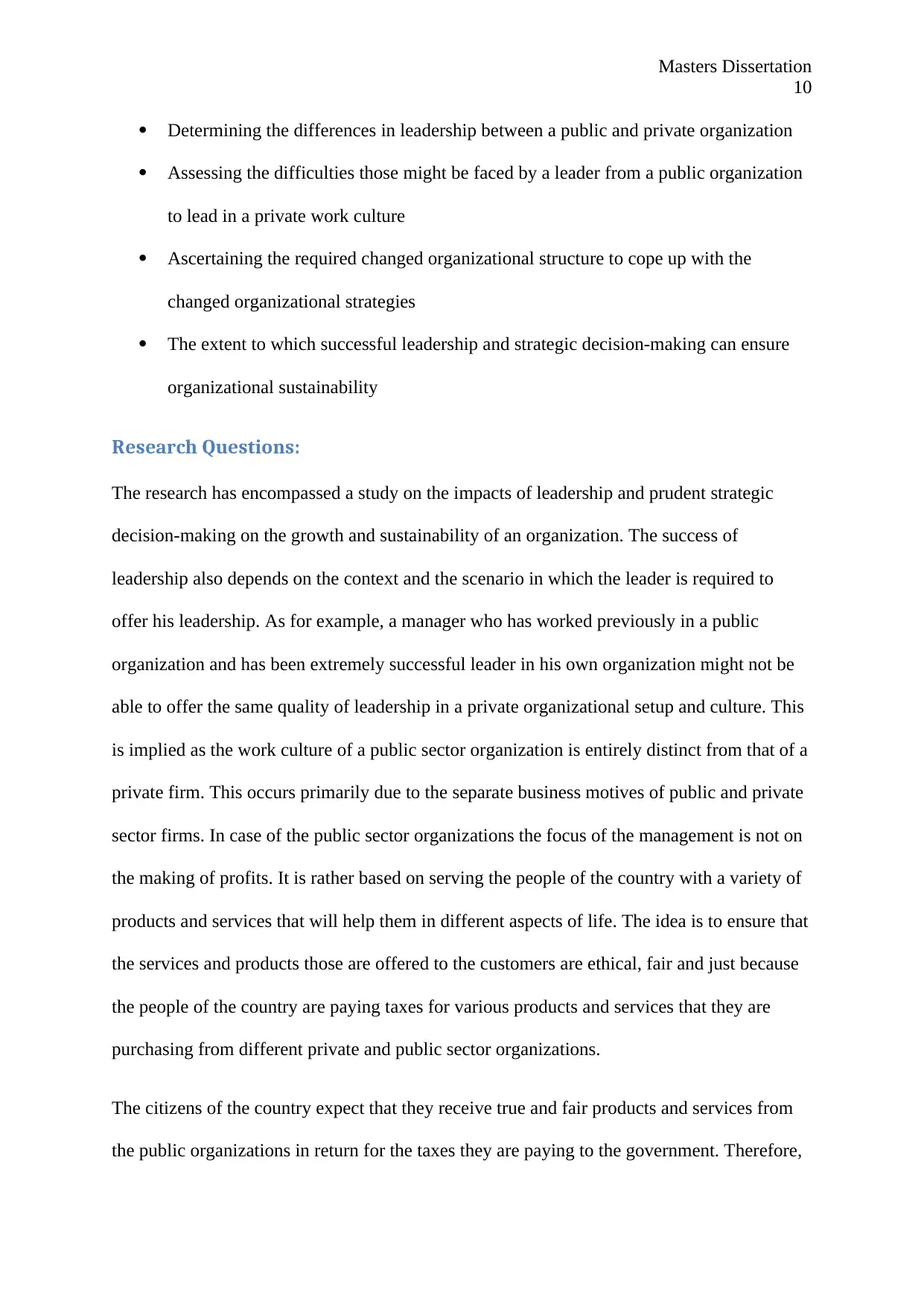
Masters Dissertation
10
Determining the differences in leadership between a public and private organization
Assessing the difficulties those might be faced by a leader from a public organization
to lead in a private work culture
Ascertaining the required changed organizational structure to cope up with the
changed organizational strategies
The extent to which successful leadership and strategic decision-making can ensure
organizational sustainability
Research Questions:
The research has encompassed a study on the impacts of leadership and prudent strategic
decision-making on the growth and sustainability of an organization. The success of
leadership also depends on the context and the scenario in which the leader is required to
offer his leadership. As for example, a manager who has worked previously in a public
organization and has been extremely successful leader in his own organization might not be
able to offer the same quality of leadership in a private organizational setup and culture. This
is implied as the work culture of a public sector organization is entirely distinct from that of a
private firm. This occurs primarily due to the separate business motives of public and private
sector firms. In case of the public sector organizations the focus of the management is not on
the making of profits. It is rather based on serving the people of the country with a variety of
products and services that will help them in different aspects of life. The idea is to ensure that
the services and products those are offered to the customers are ethical, fair and just because
the people of the country are paying taxes for various products and services that they are
purchasing from different private and public sector organizations.
The citizens of the country expect that they receive true and fair products and services from
the public organizations in return for the taxes they are paying to the government. Therefore,
10
Determining the differences in leadership between a public and private organization
Assessing the difficulties those might be faced by a leader from a public organization
to lead in a private work culture
Ascertaining the required changed organizational structure to cope up with the
changed organizational strategies
The extent to which successful leadership and strategic decision-making can ensure
organizational sustainability
Research Questions:
The research has encompassed a study on the impacts of leadership and prudent strategic
decision-making on the growth and sustainability of an organization. The success of
leadership also depends on the context and the scenario in which the leader is required to
offer his leadership. As for example, a manager who has worked previously in a public
organization and has been extremely successful leader in his own organization might not be
able to offer the same quality of leadership in a private organizational setup and culture. This
is implied as the work culture of a public sector organization is entirely distinct from that of a
private firm. This occurs primarily due to the separate business motives of public and private
sector firms. In case of the public sector organizations the focus of the management is not on
the making of profits. It is rather based on serving the people of the country with a variety of
products and services that will help them in different aspects of life. The idea is to ensure that
the services and products those are offered to the customers are ethical, fair and just because
the people of the country are paying taxes for various products and services that they are
purchasing from different private and public sector organizations.
The citizens of the country expect that they receive true and fair products and services from
the public organizations in return for the taxes they are paying to the government. Therefore,
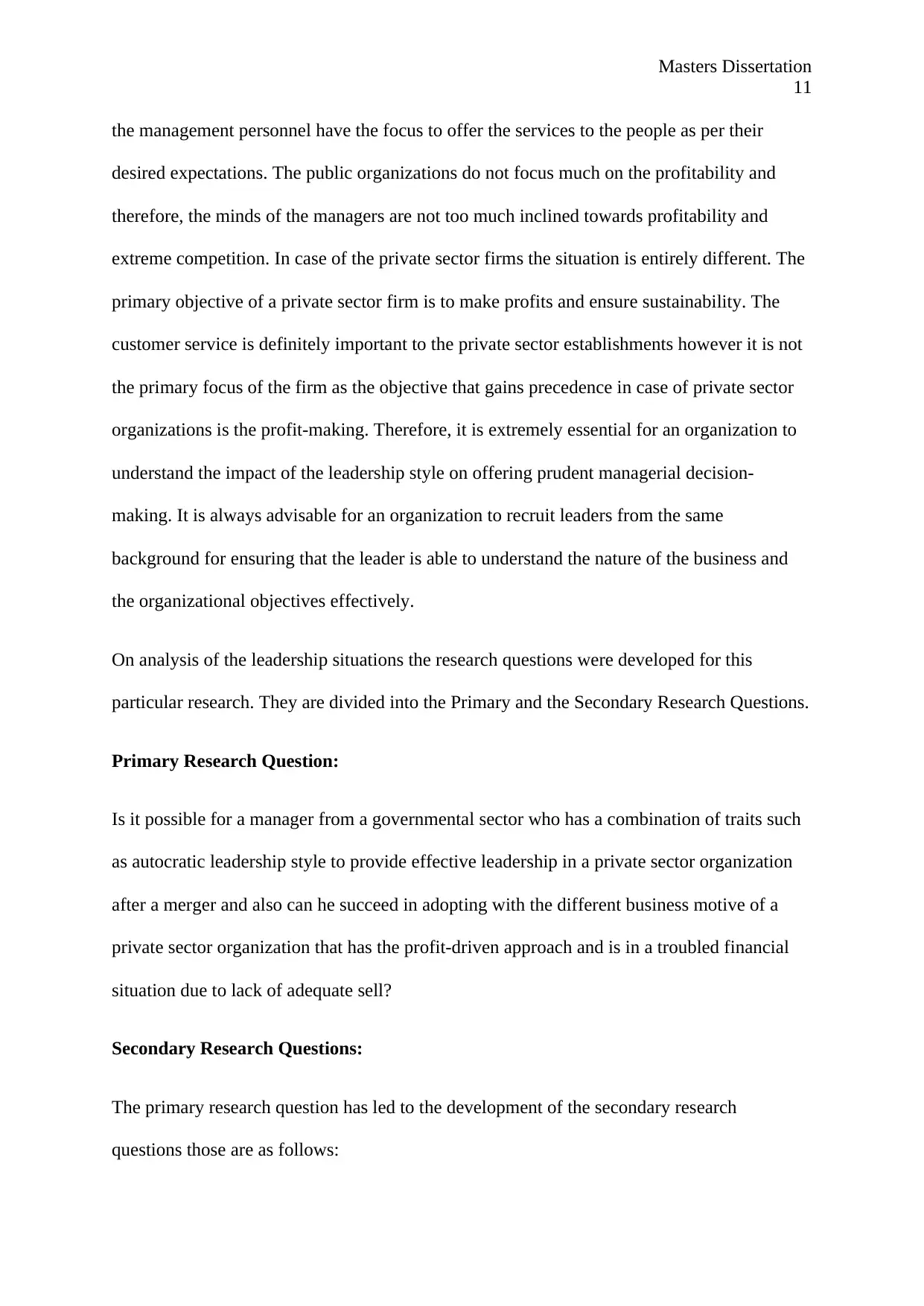
Masters Dissertation
11
the management personnel have the focus to offer the services to the people as per their
desired expectations. The public organizations do not focus much on the profitability and
therefore, the minds of the managers are not too much inclined towards profitability and
extreme competition. In case of the private sector firms the situation is entirely different. The
primary objective of a private sector firm is to make profits and ensure sustainability. The
customer service is definitely important to the private sector establishments however it is not
the primary focus of the firm as the objective that gains precedence in case of private sector
organizations is the profit-making. Therefore, it is extremely essential for an organization to
understand the impact of the leadership style on offering prudent managerial decision-
making. It is always advisable for an organization to recruit leaders from the same
background for ensuring that the leader is able to understand the nature of the business and
the organizational objectives effectively.
On analysis of the leadership situations the research questions were developed for this
particular research. They are divided into the Primary and the Secondary Research Questions.
Primary Research Question:
Is it possible for a manager from a governmental sector who has a combination of traits such
as autocratic leadership style to provide effective leadership in a private sector organization
after a merger and also can he succeed in adopting with the different business motive of a
private sector organization that has the profit-driven approach and is in a troubled financial
situation due to lack of adequate sell?
Secondary Research Questions:
The primary research question has led to the development of the secondary research
questions those are as follows:
11
the management personnel have the focus to offer the services to the people as per their
desired expectations. The public organizations do not focus much on the profitability and
therefore, the minds of the managers are not too much inclined towards profitability and
extreme competition. In case of the private sector firms the situation is entirely different. The
primary objective of a private sector firm is to make profits and ensure sustainability. The
customer service is definitely important to the private sector establishments however it is not
the primary focus of the firm as the objective that gains precedence in case of private sector
organizations is the profit-making. Therefore, it is extremely essential for an organization to
understand the impact of the leadership style on offering prudent managerial decision-
making. It is always advisable for an organization to recruit leaders from the same
background for ensuring that the leader is able to understand the nature of the business and
the organizational objectives effectively.
On analysis of the leadership situations the research questions were developed for this
particular research. They are divided into the Primary and the Secondary Research Questions.
Primary Research Question:
Is it possible for a manager from a governmental sector who has a combination of traits such
as autocratic leadership style to provide effective leadership in a private sector organization
after a merger and also can he succeed in adopting with the different business motive of a
private sector organization that has the profit-driven approach and is in a troubled financial
situation due to lack of adequate sell?
Secondary Research Questions:
The primary research question has led to the development of the secondary research
questions those are as follows:
⊘ This is a preview!⊘
Do you want full access?
Subscribe today to unlock all pages.

Trusted by 1+ million students worldwide
1 out of 63
Related Documents
Your All-in-One AI-Powered Toolkit for Academic Success.
+13062052269
info@desklib.com
Available 24*7 on WhatsApp / Email
![[object Object]](/_next/static/media/star-bottom.7253800d.svg)
Unlock your academic potential
Copyright © 2020–2025 A2Z Services. All Rights Reserved. Developed and managed by ZUCOL.





